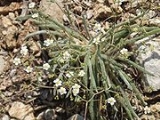
Ivesia santolinoides
Encyclopedia
Ivesia santolinoides is a species of flowering plant in the rose family
known by the common names Sierra mousetail and mousetail ivesia. It is endemic to California
where it grows in several mountain ranges, including the Sierra Nevada and Transverse Ranges
.
This is a perennial herb which can be somewhat different in appearance from many other mousetails
. Each leaf is made up of many leaflets but they are tiny and overlap tightly to form a woolly, taillike, cylindrical leaf up to 10 centimeters long. The erect, naked stem reaches up to 40 centimeters in height and bears an inflorescence
of flowers. Each flower is up to 8 millimeters wide and has large, round white petals above the much smaller, pointed sepal
s. There are 15 stamen
s and a single pistil
.
Rosaceae
Rosaceae are a medium-sized family of flowering plants, including about 2830 species in 95 genera. The name is derived from the type genus Rosa. Among the largest genera are Alchemilla , Sorbus , Crataegus , Cotoneaster , and Rubus...
known by the common names Sierra mousetail and mousetail ivesia. It is endemic to California
California
California is a state located on the West Coast of the United States. It is by far the most populous U.S. state, and the third-largest by land area...
where it grows in several mountain ranges, including the Sierra Nevada and Transverse Ranges
Transverse Ranges
The Transverse Ranges are a group of mountain ranges of southern California, in the Pacific Coast Ranges physiographic region that runs along the Pacific coast from Alaska to Mexico in North America. The Transverse Ranges begin at the southern end of the California Coast Ranges and lie between...
.
This is a perennial herb which can be somewhat different in appearance from many other mousetails
Ivesia
Ivesia is also a synonym for the Nesticus spider genus.Ivesia is a genus of flowering plants in the rose family known generally as mousetails. They are perennial herbs native to western North America, especially the western United States...
. Each leaf is made up of many leaflets but they are tiny and overlap tightly to form a woolly, taillike, cylindrical leaf up to 10 centimeters long. The erect, naked stem reaches up to 40 centimeters in height and bears an inflorescence
Inflorescence
An inflorescence is a group or cluster of flowers arranged on a stem that is composed of a main branch or a complicated arrangement of branches. Strictly, it is the part of the shoot of seed plants where flowers are formed and which is accordingly modified...
of flowers. Each flower is up to 8 millimeters wide and has large, round white petals above the much smaller, pointed sepal
Sepal
A sepal is a part of the flower of angiosperms . Collectively the sepals form the calyx, which is the outermost whorl of parts that form a flower. Usually green, sepals have the typical function of protecting the petals when the flower is in bud...
s. There are 15 stamen
Stamen
The stamen is the pollen producing reproductive organ of a flower...
s and a single pistil
Gynoecium
Gynoecium is most commonly used as a collective term for all carpels in a flower. A carpel is the ovule and seed producing reproductive organ in flowering plants. Carpels are derived from ovule-bearing leaves which evolved to form a closed structure containing the ovules...
.

